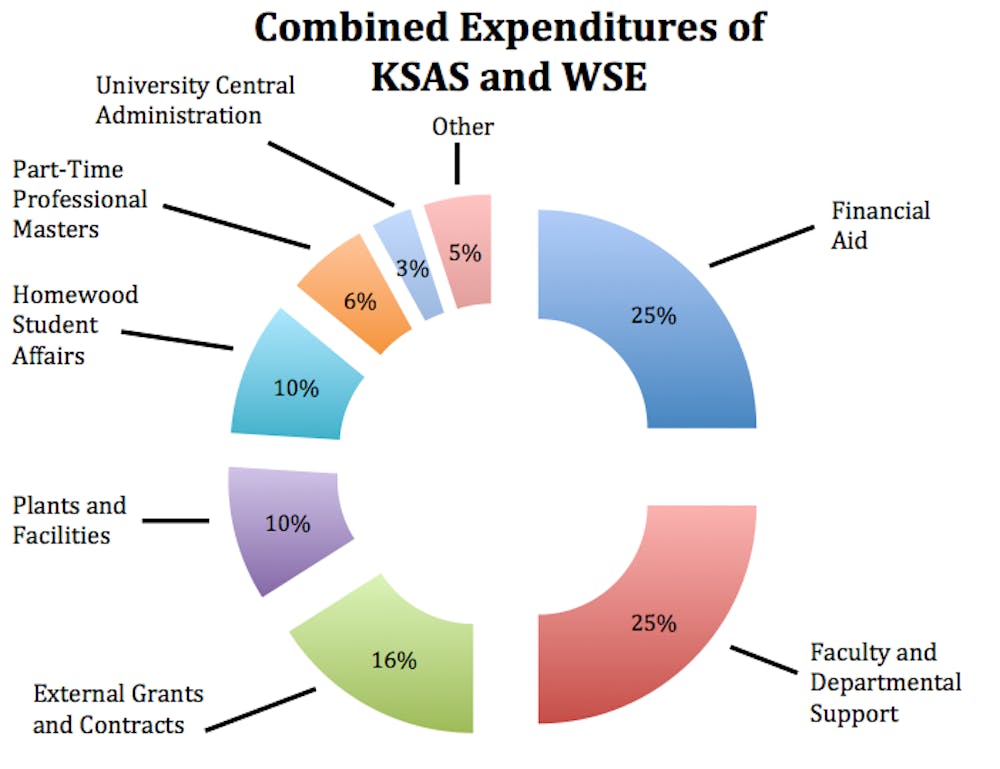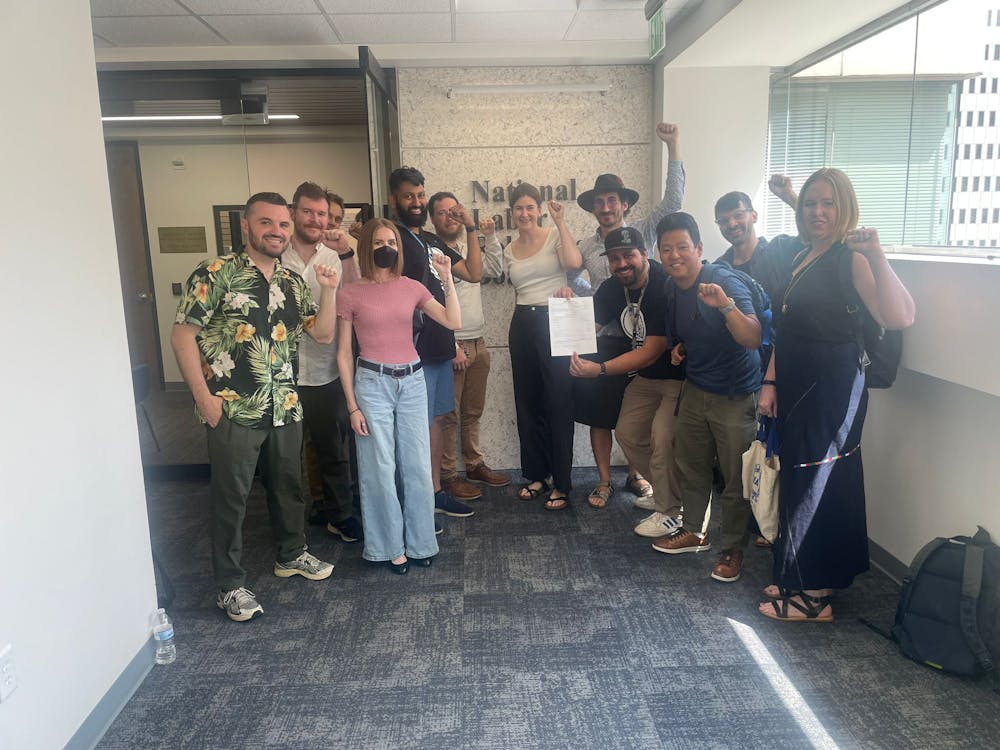See part 1 of this series here.
With undergraduate tuition steadily rising every year, many students wonder where their money goes.
The Krieger School of Arts and Sciences (KSAS) and the Whiting School of Engineering (WSE) are particularly dependent on tuition revenue because of the University’s decentralized budgetary structure. The most recent budget for KSAS totaled $350 million, with undergraduate tuition constituting 52 percent of Krieger’s revenue. Undergraduate tuition comprises 35 percent of Whiting’s $220 million budget.
When graduate tuition is taken into account, 65 percent or more of KSAS and WSE’s budgets rely on tuition.
This is drastically different from other top ten schools. Harvard, for example, can subsidize 50 percent or more of its arts and sciences school’s budget through non-tuition revenue.
Undergraduate tuition also funds Homewood Student Affairs (HSA), in addition to covering financial aid and departmental costs. HSA includes many aspects of undergraduate student life: undergraduate admissions and financial aid, academic and student services, athletics and recreation, student life and business operations.
“Homewood Student Affairs makes up 10 percent of KSAS and WSE’s combined expenditures. This funding from the schools makes up about 84 percent of HSA’s annual budget. The remainder of the budget is funded through philanthropy and other revenues,” Mary O’Connell, senior executive director of student affairs finance and administration, wrote in an email to The News-Letter. “Housing and Dining maintains its own auxiliary services budget which is funded through room and board rates.”
The two major sources of HSA philanthropic support come from the Parents’ Fund and Blue Jays Unlimited, which subsidizes athletics.
“The Parents’ Fund contributes about $1.0 million annually to fund student events including the funding of student clubs and organizations — major student events such as Lighting of the Quads, High Table, Spring Fair and class-based programs,” O’Connell wrote. “Blue Jays Unlimited (BJU) also provides significant support to our athletic programs, helping to support travel, team expenses, and some assistant coaching salaries.”
Krieger and Whiting run leaner than it might seem, operating at a two percent margin.
“I don’t think the students and faculty really appreciate the complexity and at the end of the day there is no profit. It’s not like there is a huge reserve sitting out there. We try to manage to a margin, which is around a 2 percent margin, which means our expenses are less than our revenues by 2 percent,” James Aumiller, the senior associate dean of finance and administration for WSE, said. “But even at that, I am struggling to make that [this year]. I’m hoping to just be positive.”
This two percent margin gets put into a contingency fund in the event that any financial emergencies arise. Daniel Cronin, senior associate dean of finance and administration for KSAS, emphasized that the main goal is to ensure smooth transitions when allocating and moving different parts of the budget.
“Part of our job is to make sure to think about the unexpected and help plan for it,” Cronin said. “That we understand our budget and know the pieces that are movable, and how we can make sure we don’t interrupt the educational and research mission.”
Aumiller compared The University’s bottom-up structure to centralized schools where money is distributed from the top-down. The downside to decentralization is that the Homewood schools, unlike more centralized universities, cannot access the revenue streams of more profitable schools like the School of Medicine. However this structure does give each school more flexibility and autonomy when allocating their budgets.
Even though a wide degree of autonomy exists between many of the University’s schools, Krieger and Whiting have a more symbiotic relationship. The two schools have many of the same expenditures because of their shared resources and student bodies.
“Whiting and Krieger are really joined at the hip. I don’t know how many hours a week Jim and I probably spend with each other in different meetings, so it’s not like we’re strangers,” Cronin said.
Aumiller elaborated on this relationship by describing the services both schools support financially.
“We share the library, for instance. We both fund it and help pay for it, but we share it,” he said. “Same with admissions, registrar — all the things related to undergraduate student services — is all centralized under an umbrella called Homewood Student Affairs, which Whiting and Krieger fund.”
There are also different entities funded by Krieger and Whiting which support the Homewood campus. According to Cronin, 25 percent of the total expenditure for KSAS and WSE pays for faculty and departmental support. Additionally 25 percent goes to student financial aid, 16 percent to external grants and contracts, 10 percent to plant and facilities, 10 percent to Homewood Student Affairs (HSA) and three percent to the University’s central administration.
“We have different entities that run different things. For example plant operations has its own director, David Ashwood, who runs what’s going on and he controls his budget and he makes a request to us once a year that we then fund,” Cronin said.
According to Aumiller, there are different allocation formulas for how much of Krieger or Whiting’s funds support these shared services. HSA’s budget, for example, is based on student count.
“There are many shared services, like all these things we just mentioned, and each of the shared services have a different allocation formula. Some of it is based on things like square foot, sometimes it’s based on people and so on and so forth,” he said. “Based on that, depending on which topic we’re talking about, we know that, in essence, both of us are going to get an invoice. And we’re going to contribute to that budget. But then we’re done with it. We help oversee it, and they report back to us on progress. Dan and I sit with the deans, kind of overseeing those kinds of operations.”
The only expenditure from Krieger and Whiting’s budget that does not go solely to Homewood is the three percent that supports The University’s central administration. This helps cover the cost of the shared Hopkins IT services, such as the Integrated Student Information System (ISIS). This three percent also helps support the Office of the President and other divisions of Central Administration.
“There’s a formula across all the schools that gets funded by the University administration tax. It’s a bill that doesn’t just go to us, but all of the different schools,” Aumiller said.
Krieger and Whiting help support a wide range of services around the Homewood campus. Aumiller explained that it is impossible to track where every tuition dollar gets spent. However he did say that undergraduate tuition mostly funds programs that service students.
“At the end of the day — I have this conversation with faculty all the time — they all think that we track every dollar. You give me a dollar and then I can track that dollar and can tell you exactly [where it goes]. We don’t actually track it that way. In a lot of cases it becomes a little bit blended, all the dollars,” Aumiller said. “Undergrad tuition is 35 percent of my total budget. And most of that is spoken for, covering financial aid, covering HSA. HSA doesn’t service Master’s students and it doesn’t service PhD students. It services strictly undergrads. If you really try and follow that dollar, the undergrad dollar is covering all of those kinds of expenses.”





